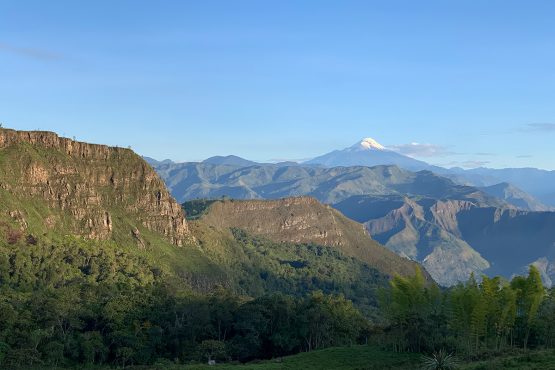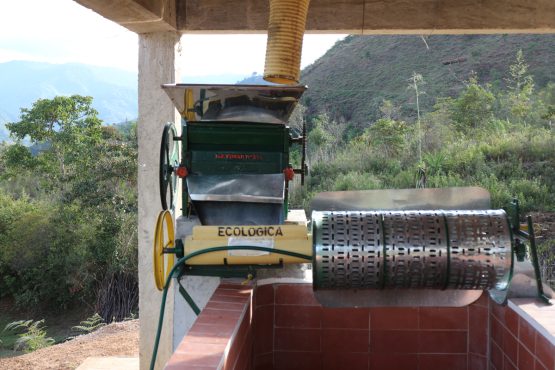El Cedro
Distinct winey acidity, with redcurrant, dark chocolate and cola. Toffee sweetness and lingering vanilla florals.
This 100% Tabi microlot was produced by Leonardo Tunubalá and his wife Rosa Alvarado on their small farm, El Cedro, located near the town of Baja Belén, in the municipality of Inzá in the state of Cauca, Colombia.
At just one hectare large, El Cedro (which translates to ‘the cedar tree’ in Spanish) is a tiny farm, situated at 1,850m above sea level, in the steep, rugged hills that surround Baja Belén. Leonardo has only recently purchased the property, although he has been working in coffee for over ten years. At El Cedro, Leo also keeps bees which help pollinate the coffee trees he tends to.
Leonardo’s story is one of self-improvement and determination. When he first joined Pergamino’s Allied Producer Program, the coffee he delivered rarely scored above 84 points and, as a result, was blended into larger regional lots. While this guaranteed a reliable income to him and his family, it didn’t earn him the extra financial premiums that microlots could. Léo decided to revise and improve every aspect of his harvest work: from the picking of the cherries, to the way these were processed. He began implementing extended fermentation before drying his parchment, which added complexity and sweetness to the coffee he produced.
His coffee began receiving higher cup scores and was eventually selected to be sold as a microlot to the international market. Recounting how receiving that news felt, Léo says: “When they told me that my coffee had been separated as microlot, [I felt] joy and pride knowing that it would be enjoyed on the other side of the world. This sort of news gives me the morale boost to continue. Working in coffee is very difficult. However, we always work with our hearts, and even if our production is small, it means the world to us.”
We are thrilled to be offering Leonardo and Rosa’s coffee, and are excited to see his production grow!
El Cedro is mainly planted with Tabi, a variety known for producing an exceptional cup, though it is susceptible to disease. The high elevation of Leonardo’s farm (1,850 metres above sea level) makes it possible to continue growing this more vulnerable variety, as the cooler temperature mitigates the risk of coffee leaf rust. At such high elevation, coffee cherries are able to ripen more slowly, allowing a higher concentration of sugars to develop and resulting in a sweet and elegant cup. Léo farms his coffee with traditional techniques, with most of the labour is provided by him and Rosa. Fertilisation occurs around three times a year, usually after manual weeding, and pesticides are rarely used.
Like most of the nearby towns, Baja Belén has breathtaking views of Colombia’s highest volcano, Nevado del Huila, which sits at the point where the states of Huila, Tolima and Cauca meet. The rich, volcanic region of the area makes it ideal for agriculture and contributes to the excellent cup quality of coffees grown and processed here. Cool overnight temperatures result in dense beans, which are notable for their sweetness and complexity. Lower temperatures and high rainfall also influence processing techniques, with longer-than-usual ferment and drying times being necessary.
ABOUT INZÁ
The municipality of Inzá is located in the corner Cauca state, bordering with Tolima and Huila and looking out to the west over the Pacific Ocean. This region has excellent conditions for growing high-quality coffee, with high elevations and rich volcanic soil. The plateau has a very stable climate year-round thanks to its proximity to the equator and the surrounding mountains, which protect the coffee against the humidity of the Pacific Ocean and the trade winds from the south. This region is an important source of water and wildlife for Colombia, in addition to being prime coffee-growing land.
Inzá is the traditional home of the Nasa (or Páez) people, one of Colombia’s largest indigenous groups. During the Spanish invasion of Colombia, many of the Nasa were able to avoid bloodshed by escaping to the rugged hills and high plateaus of the Andes Mountains where the Spaniards were unable to pursue them. Today, the Nasa economy relies on agriculture, and society is organised into tight knit farming communities who distribute duties equitably under the guidance of cabildos, or locally elected councils. Like many indigenous groups across Latin America, the Nasa have spent decades lobbying for the return of their land rights, finding success in recent years. Their struggle has led to legal recognition of the fundamental rights of indigenous peoples, including recognition of the autonomy of their communal indigenous lands in the 1991 Colombian Constitution.
Coffee from Cauca has historically been very difficult to access due to the region’s isolation and instability. For many years this part of Colombia was under the control of Colombia’s notorious rebel group, the FARC, and as a result, it was unsafe and violent. Since 2012, safe access to this region has been possible as a result of peace talks between the national government and the rebels. Thanks to these efforts, more and more stunning coffees from small producers in the region have become accessible to international buyers.
Our export partners for this coffee, Pergamino, have worked hard commercialise specialty-grade coffee throughout Cauca, and are now able to source some outstanding coffees from very dedicated producers. They work closely with the producers to give them feedback on their coffees (provided by Pergamino’s expert team of cuppers) and provide top up payments when the coffee is sold at a higher premium.
Head here to learn more about the work of Pergamino.
HOW THIS COFFEE WAS PROCESSED
The coffee in this lot was selectively hand-harvested, with most labour being provided by Leonardo and his wife Rosa. It was processed using the washed method at the farm’s ‘micro-beneficio’ (mill).
Freshly picked cherries were pulped using a small manual or electric pulper and then placed into a fermentation tank, where the parchment fermented without water. Leo pulped and blended several days’ worth of pickings over a 3-5 day period, lowering the pH level in the tank and – along with the cooler temperatures – allowing for an extended fermentation process. This fermentation process contributes to a vibrant, winey acidity in the coffee’s cup profile. This parchment is then washed using clean water from nearby rivers and streams.
The coffee was then carefully dried (over 10–18 days) on parabolic beds, which are constructed a bit like a ‘hoop house’ greenhouse, and act to protect the coffee from the rain and prevent condensation dripping back onto the drying beans. The greenhouses are constructed out of plastic sheets and have adjustable walls to help with airflow, and temperature control to ensure the coffee can dry slowly and evenly.
Once dry, the coffee was delivered to Pergamino’s warehouse in Medellín, where it was cupped and graded. Once approved, coffee rested in parchment until it was ready for export.














